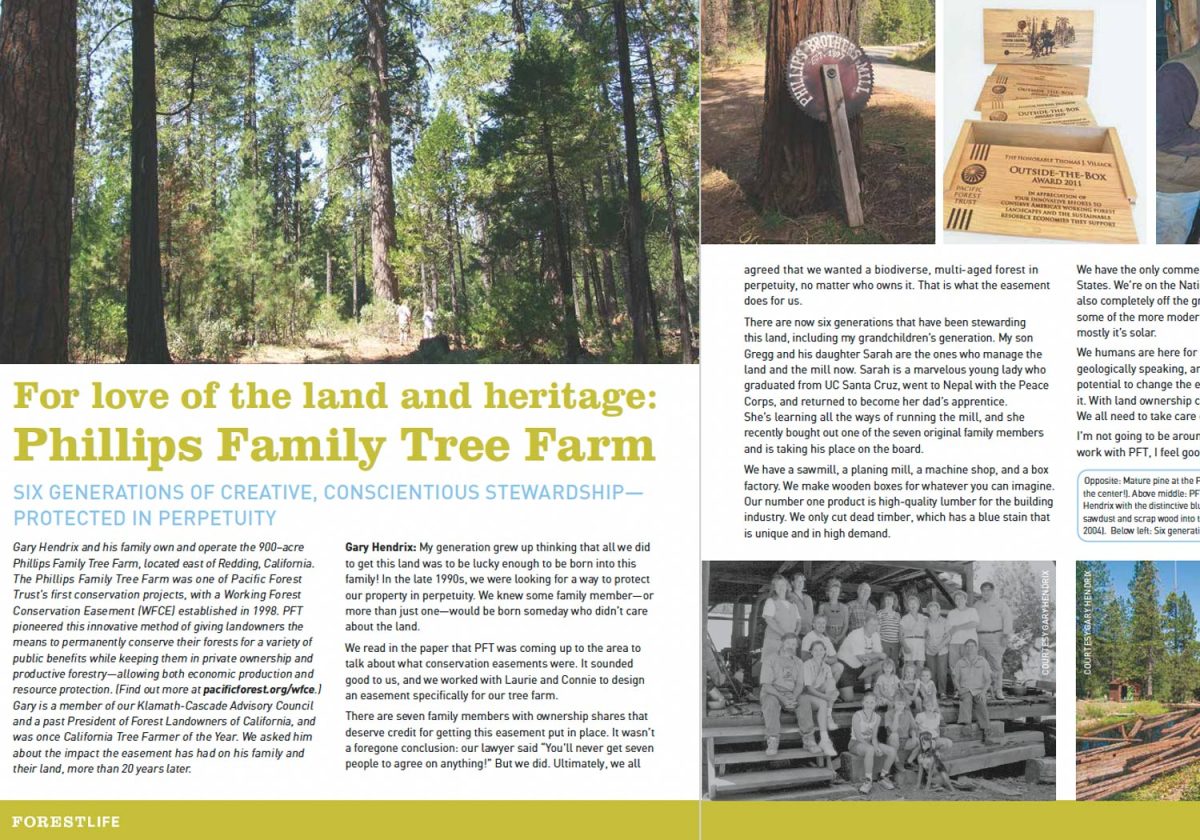
My last project at Pacific Forest Trust was the Spring 2020 issue of the organization’s newsletter, Forest Life. As Communications Manager, my role was to manage the entire publication, from doing the layout and most of the writing and editing to working with printers and mailers. For this issue, the Co-CEO made broad decisions about what to cover, oversaw my work, and made some final edits.
Here’s my preferred earlier draft of one article, a profile of a landowner who was one of the first to agree to a conservation easement with PFT. I spoke with the landowner on the phone and condensed our conversation into a piece in his own words. View it with photos and captions in the PDF.
For love of the land: Phillips Family Tree Farm
Six generations of creative, conscientious stewardship—protected in perpetuity
Gary Hendrix, as told to Jason Gohlke
Gary Hendrix and his family own and operate the 900–acre Phillips Family Tree Farm, located east of Redding near Oak Run. The Phillips Family Tree Farm was one of Pacific Forest Trust’s first Working Forest Conservation Easements (WFCEs). PFT pioneered this innovative form of the traditional conservation easement, which gives landowners the means to permanently conserve their forests for a variety of public benefits while keeping them in private ownership and productive forestry—allowing both economic production and resource protection. (Find out more at pft.news/wfce.) We asked him about the effects the easement has had on his family and the land, more than 20 years later.
In his own words:
My generation grew up thinking that all we did to get this land was to be lucky enough to be born. At the time, we were really looking for a way to protect our property in perpetuity; we knew someone would be born someday who didn’t care about the land.
We read in the paper that PFT was coming up to the area to talk about what conservation easements were. It sounded good to us, and we worked with Laurie and Connie to design an easement specifically for our tree farm.
There are seven family members with ownership shares that deserve credit for getting this easement put in place. It wasn’t a foregone conclusion: our lawyer said “You’ll never get seven people to agree on anything!” But we did. Ultimately, we all agreed that we wanted a biodiverse, multi-aged forest in perpetuity, no matter who owns it.
There are now six generations that have been stewarding this land, including my grandchildren’s generation. My son Gregg and his daughter Sarah are the ones who manage the land and the mill now. My granddaughter Sarah is a marvelous young lady who graduated from UC Santa Cruz, went to Nepal with the Peace Corps, and returned to become her dad’s apprentice. She’s learning all the ways of running the mill, and she recently bought out one of the seven original family members and is taking his place on the board.
We have the only commercial steam mill left in the United States. We’re on the National Registry of Historic Places. We’re also completely off the grid. We have a 50 KW generator for some of the more modern equipment and cloudier days, but mostly it’s solar.
We have a sawmill, a planing mill, a machine shop, and a box factory. We make wooden boxes for whatever you can imagine. But our number one product is high-quality lumber for the building industry. We only cut dead timber, which has a blue stain that is unique and in demand. We can’t compete with the major lumber companies, but we provide things builders can’t get from them.
We’re here for less than the blink of an eyelash, geologically speaking, and yet as human beings we have the potential to change the entire world. With ownership comes responsibility for stewardship: We all need to take care of the gifts we’ve been given. I’m not going to be around forever, but I feel good about what I’m leaving behind.